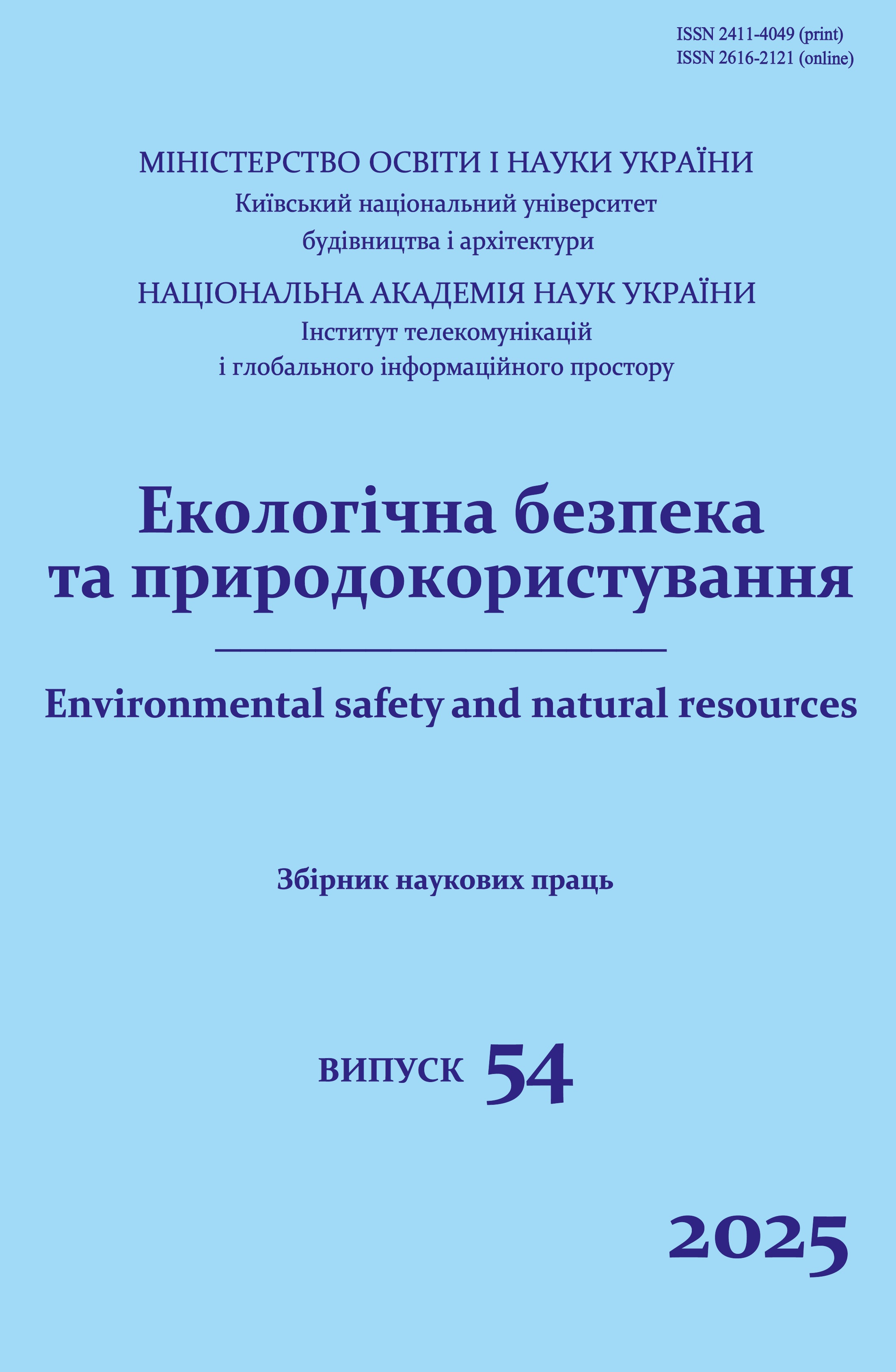Decoderation of satellite images of water protection zones using artificial intelligence system
DOI:
https://doi.org/10.32347/2411-4049.2025.2.110-120Keywords:
geographic information systems, remote sensing methods, environmental safety, regulatory distances, landfills of agricultural lands and buildings located within nature conservation water protection zones, nature conservation water protection zones, environmental protection technology, ecosystemAbstract
The work is devoted to the application of an artificial intelligence system to assess violations of the norms of environmental water protection strips along the Dnieper and several middle rivers in the Dnipropetrovsk region. The use of artificial intelligence allows you to form vector layers of agricultural fields located in the zone of water protection strips, as well as the field of the building line along the banks of rivers, elements of which violate the norms of the distance to water bodies.
Diagnostics and forecasting of situations using aerospace technologies involves the use of a set of models of ecosystem objects in the intelligent system of environmental protection and territories with varying degrees of environmental threats to objects. This approach allows you to perform spatially distributed assessment of environmental risk and diagnostics of the ecological situation in ecosystems.
The methodology for applying aerospace technologies to solve environmental problems using an artificial intelligence system allows for the integration of environmental monitoring data from various observation sources: stationary observation points, ground-based mobile complexes, remotely piloted aircraft, and space-based remote sensing systems.
The use of aerospace technologies in environmental safety management using artificial intelligence systems involves the following stages: identification of risk factors, risk assessment, risk management in the ecosystem. Formalization of tasks in the field of environmental monitoring using artificial intelligent systems with the use of aerospace technologies takes into account: geology and subsoil resources (including groundwater), hydrology and surface water resources, forest resources and plant cover, impacts on the environment, wildlife, atmospheric air, precipitation and snow cover, communication facilities, agriculture, use and development of territories.
References
Krasovsky, G.Ya., Trofymchuk, O.M., Kreta, D.L., Klymenko, V.I., Ponomarenko, I.G., & Sukhodubov, O.O. (2005). Synthesis of cartographic models of land pollution by man-made dust using space images. Ecology and resources, 12, 37-55 [in Ukrainian].
Trofymchuk, O., Kalyukh, Y., & Hlebchuk, H. (2013). Mathematical and GIS-modeling of landslides in Kharkiv region of Ukraine. In Landslide Science and Practice: Spatial Analysis and Modelling (pp. 347-352). Springer, Berlin, Heidelberg.
Trofymchuk, O.M., Adamenko, O.M., & Trysnyuk, V.M. (2021). Geoinformation technologies for environmental protection of the nature reserve fund. Ivano-Frankivsk: Suprun V.P. ISBN 978-617-7468-53-9 [in Ukrainian].
Mashkov, O.A., Trysnyuk, V.M., Mamchur, Y.V., Zhukauskas, S.V., Nigorodova, S.A., & Kurylo, A.V. (2019). A new approach to the synthesis of restorative control for remotely piloted aerial vehicles for environmental monitoring. Environmental safety and balanced resource use: science and technology journal, 1(19), 69-77 [in Ukrainian].
Andreyev, S.M., Kreta, D.L., & Radchuk, V.V. (2008). Development of cartographic models of marine areas and coastal areas using geoinformation technologies. In "Modern information technologies for managing environmental safety, nature use, and emergency measures": materials of the VII int. scientific-practical conf. (pp. 112-117). Kyiv – Kharkiv – AR Crimea.
Trysnyuk, V.M., Okhariev, V.O., Trysnyuk, T.V., Zorina, O.V., Kurylo, A.V., Golovan, Y.V., Smetanin, K.V., & Radlowska, K.O. (2019). Improving the algorithm of satellite images landscape interpretation. In 18th International Conference Geoinformatics – Theoretical and Applied Aspects, Extended Abstracts.
Trysnyuk, V., Trysnyuk, T., Okhariev, V., Shumeiko, V., & Nikitin, A. (2018). Cartographic Models of Dniester River Basin Probable Flooding. Сentrul Universitar Nord Din Bala Mare UTPRESS ISSN 1582-0548, 1, 61–67.
Retrieved from https://delo.ua/ukraine/verhovnaja-rada-zapretila-stro-148398/©delo.ua
Retrieved from http://iportal.rada.gov.ua/ru/news/page/news/Novosty/Soobshchenyya/36927.html
Law no. 2740-VI from 02.12.2010 "On Amendments to the Water and Land Codes of Ukraine Regarding Coastal Protection Stripes" (the draft law was registered under No. 2642).
Resolution of the Verkhovna Rada of Ukraine On the National Program for Environmental Improvement of the Dnieper Basin and Improvement of Drinking Water Quality, Kyiv, February 27, 1997, No. 123/97-VR.
Downloads
Published
How to Cite
Issue
Section
License
Copyright (c) 2025 Oleg Mashkov, Volodymyr Prysyazhny

This work is licensed under a Creative Commons Attribution 4.0 International License.
The journal «Environmental safety and natural resources» works under Creative Commons Attribution 4.0 International (CC BY 4.0).
The licensing policy is compatible with the overwhelming majority of open access and archiving policies.

